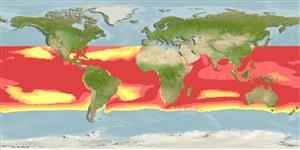(كوسه ها و سپرماهيان) (sharks and rays) >
Squaliformes (Sleeper and dogfish sharks) >
Dalatiidae (Sleeper sharks)
Etymology: Isistius: Etymology not explained, probably iso-, from isos (Gr.), equal; istius, from histion (Gr.), sail (i.e., dorsal fin), referring to its two similarly shaped and sized (and posterior) dorsal fins, a character Gill used to diagnose genus. José I. Castro, The Sharks of North America (Oxford University Press, 2011), suggests name may allude to the Egyptian goddess Isis, represented in statuary with her head veiled, or to the dark collar encircling throat of I. brasiliensis, “which could also suggest a veil over the head” (p. 145). This interpretation is rejected by the fact that Gill often used “istius” in the names of several genera distinguished (at least in part) by their dorsal fins (Acanthistius, Brachyistius, Caristius, Dichistius, Goniistius, Iniistius, Micromesistius, Nematistius). (See ETYFish); brasiliensis: -ensis, Latin suffix denoting place: off the coast of Brazil, type locality. (See ETYFish).
More on authors: Quoy & Gaimard.
Environment: milieu / climate zone / depth range / distribution range
بوم شناسي
دريايي ناحیه ای از منطقه اقیانوسی با عمق بین 1000 تا 4000 متر. موجوداتی که در آبهای آزاد بین اعماق 1000 تا 4000 متر زندگی و تغذیه می کنند; اقیانوس رو (Ref. 51243); تغييرات عمق 0 - 3700 m (Ref. 55584), usually 0 - 1000 m (Ref. 89423). Deep-water; 35°N - 47°S, 180°W - 180°E
Western Atlantic: Bahamas and southern Brazil. Eastern Atlantic: Cape Verde, Guinea to Sierra Leone, southern Angola and South Africa, including Ascension Island. Indo-Pacific: Mauritius to New Guinea, Lord Howe Island, and New Zealand (Ref. 26346), north to Japan and east to the Hawaiian Islands. Eastern Pacific: Easter Island (Ref. 9068) and the Galapagos.
Length at first maturity / Size / Weight / سن
Maturity: Lm 41.0, range 38 - 44 cm
Max length : 42.0 cm TL جنس نر / بدون خواص جنسي; (Ref. 48844); 56.0 cm TL (female)
خارهاي باله پشتي (کل): 0; شعاع نرم باله پشتي (کل): 0; خارهاي باله مخرجي 0; شعاع نرم باله مخرجي: 0; مهره ها: 81 - 89. The cookiecutter shark Isistius brasiliensis is distinctive for the prominent dark collar marking around its throat, large nearly symmetrical caudal fin with a long ventral lobe over 2/3 length of dorsal caudal margin, and moderately large lower teeth in 25-32 rows. Eyes set anterior of head but sufficiently far back to lack an extensive anterior binocular field. Pectoral fins subquadrate; pelvic fins larger than dorsal fins (Ref.247). Tooth count: 30-37/25-31. Vertebral count: 81-89. Spiral valve count: 8-10 (Ref. 48844). Dark brown dorsally, paler ventrally except for blackish band across throat; tips of caudal lobe blackish (Ref. 6577). As with the other member of the genus Isistius , it has a characteristic small cigar-shaped body with two small close-set spineless dorsal fins far posterior on back, no anal fin, huge, triangular-cusped teeth without blades, short, bulbous snout and a unique suctorial lips (Ref. 247).
Oceanic species (Ref. 247). Epi- to bathypelagic at 1-3500 m (Ref. 58302). Makes diurnal vertical migrations from below 1,000 m in the day to or near the surface at night (Ref. 6871, 58302). Travels long vertical distances in excess of 2,000 to 3,000 m on a diel cycle (Ref. 247). Feeds free-living deepwater prey such as large squid, gonostomatids, crustaceans but is also a facultative ectoparasite on larger pelagic animals such as wahoo, tuna, billfishes, and cetaceans (Ref. 247). Ovoviviparous (Ref. 205), with 6-12 young per litter (Ref. 48844). The cookiecutter shark has specialized suctorial lips and a strongly modified pharynx that allow it to attach to the sides of it prey (Ref. 247). It then drives its saw-like lower dentition into the skin and flesh of its victim, twists about to cut out a conical plug of flesh, then pull free with the plug cradled by its scoop-like lower jaw and held by the hook-like upper teeth (Ref. 247). Teeth are shed as a complete unit; the lower teeth are swallowed, perhaps to maintain sufficient calcium levels in its body (Ref. 247). Interconnection at the bases of individual tooth allows a whole row of teeth to move if one tooth is touched. This shark is reported to radiate light for as long as three hours after its death. Not dangerous to people because of its small size and habitat preferences (Ref. 247).
Life cycle and mating behavior
بلوغ | تولید مثل | تخم ریزی | تخم ها | Fecundity | توزاد ( لارو)
Presumably ovoviviparous; 6 or 7 large eggs have been found in ovaries (Ref. 247). Distinct pairing with embrace (Ref. 205). Viviparous, without a yolk sac placenta, 6-12 young per litter. Males mature at about 36 cm, with a maximum length of 42 cm; females mature at 39 cm, with a maximum length of 56 cm. Size at birth is unknown. (Ref. 48844).
Compagno, L.J.V., 1984. FAO Species Catalogue. Vol. 4. Sharks of the world. An annotated and illustrated catalogue of shark species known to date. Part 1 - Hexanchiformes to Lamniformes. FAO Fish. Synop. 125(4/1):1-249. Rome, FAO. (Ref. 247)
وضعيت در فهرست قرمز IUCN (Ref. 130435)
استفاده انسانی
ماهي گيري – شيلات: ارزش تحاري اندك
اطلاعات بيشتر
مراجعآبزي پرورينمايه آبزي پرورينژادهاژنتيكElectrophoresesوارثبيماري هافرآوریNutrientsMass conversion
ابزارها
گزارش های ويژه
بارگيری XML
منابع اينترنتي
Estimates based on models
Preferred temperature (Ref.
123201): 3.1 - 9.7, mean 4.8 °C (based on 2327 cells).
Phylogenetic diversity index (Ref.
82804): PD
50 = 0.7520 [Uniqueness, from 0.5 = low to 2.0 = high].
Bayesian length-weight: a=0.00372 (0.00141 - 0.00976), b=3.12 (2.89 - 3.35), in cm total length, based on LWR estimates for this (Sub)family-body shape (Ref.
93245).
Trophic level (Ref.
69278): 4.3 ±0.3 se; based on diet studies.
جهندگی (Ref.
120179): خیلی آهسته, كمينه زمان لازم براي دو برابر شدن جمعيت بيش از 14 سال (Fec = 6).
Fishing Vulnerability (Ref.
59153): Moderate vulnerability (42 of 100).
